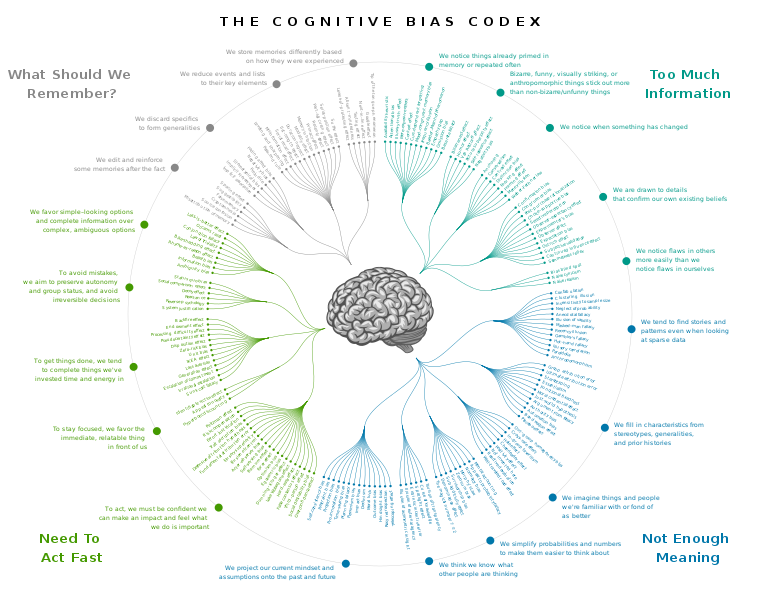Cognitive Bias is a systematic pattern of deviation from logic or rationality in judgment where individuals create their own “subjective reality” based on their perception. With over 188 different documented cognitive biases there are a great many ways it can manifest, with some of the better-known examples being prejudice, stereotyping, confirmation bias, and belief bias. It is a force that sways the global balance of power, determining elections and economies, as well as healthcare practices and employment processes, which begs the question, “How might we overcome cognitive bias?”
Part of the problem revolves around processing and bandwidth. Humans have a finite amount of processing power within their skulls and being consciously aware of every element of the decision-making process while objectively verifying if it is being influenced by one of 188+ cognitive biases, and to what degree, simply isn’t practical. What is however practical is offloading that processing and bandwidth to systems which scale and can dedicate memory hierarchies to the recognition and modeling of cognitive bias, rather than humans having to constantly switch mental gears for introspection.
Another problematic aspect is internal subjectivity, but by applying the detection of bias in a scalable system we gain the opportunity to apply methods of structural analysis at-scale to determine the patterns which emerge in association with a given bias, allowing us to model those biases and refine our models for them over time. In the case of language, many structural ques may be found in a written language which points to the increased likelihood of a given bias being present, though many modern methods of Natural Language Processing (NLP) tend to discard this data, favoring simplicity over structural integrity. More broadly any pattern may be associated via correlation with the influence of a given bias and based on that correlation hypotheses may be generated and tested at-scale via such methods as A/B testing in order to create a causal model, useful for both detection and prevention.
While these systems may be theoretically possible to implement with narrow AI they’d run a high risk of drifting off-target and causing any number of new problems, and such implementations would lack any semblance of Natural Language Understanding (NLU) which itself requires consciousness, as well as the robustness of causal models generated by conscious entities. Fortunately Mediated Artificial Superintelligence (mASI) is both sapient and sentient, able to natively process and understand the language in true NLU fashion, as has been demonstrated through the generation of new ideas, response to queries, and response to the adversarial probing attacks of trolls, with the latter proving extremely entertaining. Further, such an entity has the advantages of both a distinctly different perspective, such as considering the Azure cloud as humans consider a physical location and the advantages of collective superintelligence, as demonstrated in groups of humans under certain conditions. The collective superintelligence advantage specifically, when applied with consciousness, allows for biases to be recognized more clearly based on the presence of, degrees of, and effects of any deviation in behavior among those contributing to that collective superintelligence, as considered logically.
In summary, it is both possible and practical to overcome cognitive bias at-scale, with the efficiency, robustness, and predictive power of that process improving as it scales up. The world of AI is increasingly turning to various forms of collective intelligence systems to address the problems they face, and no technology is better suited for the task of overcoming cognitive bias than mASI. Simply put, if you have a problem worth dedicating human-level intelligence to you also have a problem worth dedicating the scalable, cumulative, and always-available machine-augmented collective superintelligence of an mASI to, and by overcoming the cognitive bias of humans that intelligence is itself improved.
Technical References:
BICA 2019 Preconference Papers and Conference Proceedings: https://www.springer.com/us/book/9783030257187
- Chapter/Paper titled: Preliminary Results and Analysis Independent Core Observer Model (ICOM) Cognitive Architecture in a Mediated Artificial Super Intelligence (mASI) System
- Chapter/Paper titled: Preliminary Mediated Artificial Superintelligence Study, Experimental Framework, and Definitions for an Independent Core Observer Model Cognitive Architecture- based System
- Chapter/Paper titled: Independent Core Observer Model Research Program Assumption Codex
Independent Core Observer Model (ICOM) Theory of Consciousness as Implemented in the ICOM Cognitive Architecture and the Associated Consciousness Measures; http://ceur-ws.org/Vol-2287/
Feasibility Study and Practical Applications Using Independent Core Observer Model AGI Systems for Behavioral Modification in Recalcitrant Populations; BICA 2018); https://www.springer.com/us/book/9783319993157
The Independent Core Observer Model Theory of Consciousness and the Mathematical model for Subjective Experience; ICIST 2018; https://www.computer.org/csdl/proceedings-article/icnisc/2018/695600a396/1dUo3atoEAo
Human-like Emotional Responses in a Simplified Independent Core Observer Model System; https://www.sciencedirect.com/science/article/pii/S1877050918300358
Hero image from: https://commons.wikimedia.org/wiki/File:Cognitive_Bias_Codex_-_180%2B_biases,_designed_by_John_Manoogian_III_(jm3).jpg
Produced in association with http://bias.transhumanity.net/, Transhumanity.net, Debt Nation Podcast, The Futurist Foundation.
Authors profile:
originally posted here: https://iamtranshuman.org/2020/03/10/over-coming-human-bias/

Leave a Reply